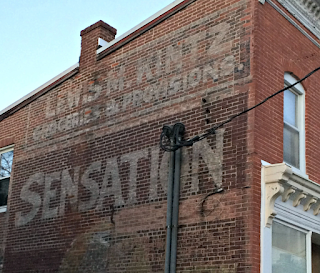Amputated Hand Rests in Family Cemetery
In 1976, the Hagerstown Daily Mail profiled a ruined historic house, originally an 18th century stone tavern, in the Washington County community of Huyett (pronounced "Hewitt"), a.k.a. Huyetts Crossroads. The most interesting thing about the property – “disclosed with much secrecy,” the reporter coyly noted – was mentioned only in the last sentence of the article:
The amputated hand of one of the past residents lies buried in the family graveyard.
That’s all I know; the rest is speculation. I don’t even know whether the house still exists, on the north side of Alternate U.S. 40 just west of Maryland Route 63. Its family graveyard is listed, however, on the Find a Grave website, which documents 16 burials there.Of the adults buried in the cemetery, only one, Jacob H. Myers (1828-1909), would have been of fighting age during the Civil War. If Jacob lost a hand on the battlefield, preserving it for home burial would have been odd but not unheard-of, as any Civil War buff could tell you. Two examples:
- Union Maj. Gen. Daniel E. Sickles lost a leg at Gettysburg, demanded it be preserved in alcohol so that he could keep it always, and later donated it to the U.S. Army Medical Museum, where he visited it several times.
- After Confederate Gen. Thomas “Stonewall” Jackson lost an arm at Fredericksburg, Virginia, his admirers gave the arm a full Christian burial at Ellwood Manor, near the field hospital where the surgery occurred. Later, the arm even got its own tombstone.
Aside from the amputated hand, the house inevitably had acquired a haunted reputation through the years: “Various residents and visitors reported unusual noises, and tales were spun of ghosts who sneaked out of closets.”
The house’s other distinctions all sprang from its location on busy U.S. 40:
- “There was a sharp curve there and cars were constantly coming over the bank, anytime on an icy night,” recalled Alta Hoffman Neikirk, who moved into the house after her marriage in 1921. She noted that the hedge “sorta broke the speed” of the cars that wound up in the front yard.
- Neikirk also recalled a “constant flow of homeless foot travelers who begged meals” and were fed on the back porch. “Hardly a winter night passed when someone didn’t sleep in the barn. We even had regular tramps, especially a Mr. Dursang who made willow baskets.”
- “At one time,” notes reporter Ora Ann Ernst, “cats took over the place, large numbers apparently being dumped by travelers on the road.”
Sources:
“Andrew Summers Graveyard.” Find a Grave. Accessed 6 Nov. 2021 at https://www.findagrave.com/cemetery/2352714/andrew-summers-graveyard.
Dickey, Paula Stoner. “Kershner-Summers-Groh House (WA-V-054).” Inventory Form for State Historic Sites Survey. Maryland Historical Trust. October 1976. PDF accessed 6 Nov. 2021 at https://mht.maryland.gov/.
“Ellwood Manor.” Fredericksburg & Spotsylvania National Military Park, Virginia. National Park Service. Accessed 6 Nov. 2021 at https://www.nps.gov/frsp/learn/historyculture/ellwood.htm.
Ernst, Ora Ann. “Old house has everything – history, close escape and haunts.” The Daily Mail (Hagerstown, Maryland), 30 October 1976, Page 6. Accessed 6 Nov. 2021 at Newspapers.com.
Garrison, Webb. More Civil War Curiosities: Fascinating Tales, Infamous Characters, and Strange Coincidences. Nashville, Tenn.: Rutledge Hill P, 1995. For the amputated leg of Sickles, see Pages 50-51.
"Huyett." The Place Names of Maryland: Their Origin and Meaning by Hamill Kenny (Baltimore: Maryland Historical Society, 1984; 2nd printing, 1999), Page 118.
Martinez, Ramona. “The Curious Fate Of Stonewall Jackson’s Arm.” Morning Edition. National Public Radio. 28 June 2012. Accessed 6 Nov. 2021 at https://www.npr.org/2012/06/28/155804965/the-curious-fate-of-stonewall-jacksons-arm.

Comments
Post a Comment